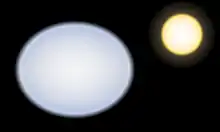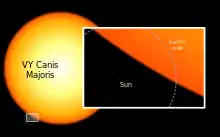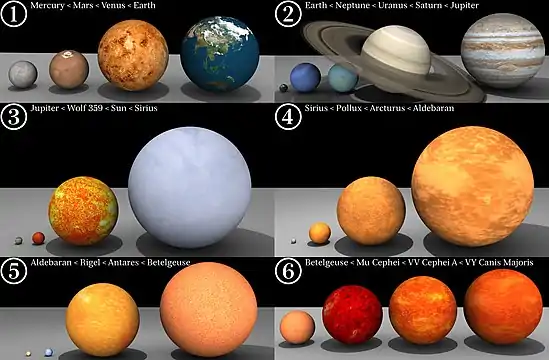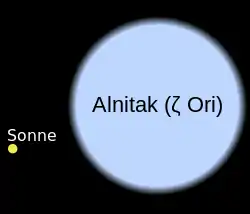Liste der größten Sterne
Die größten bekannten Sterne sind nachfolgend, sortiert nach ihrem Radius, aufgelistet. Der Radius ist als Verhältnis zum Sonnenradius (mit 696.300 km die Hälfte des Sonnendurchmessers) angegeben.
Die angegebenen Radien sind Schätzwerte mit teilweise großen Schwankungen. Zudem sind Doppelsternsysteme manchmal in ihre Einzelsterne aufgelöst angegeben, in anderen Fällen als Einzelobjekt aufgeführt. Daher bietet diese Liste nur einen Anhaltspunkt und keine gesicherte Rangfolge.

Vergleich Wega – Sonne

Vergleich Rigel – Sonne

Vergleich der roten Riesen im Westerlund-1-Sternhaufen

Vergleich Sonne – VV Cephei

Vergleich Sonne – VY Canis Majoris. (Um die Sonne zu sehen, muss das Bild in voller Größe angezeigt werden.)
| Rang | Stern | Sonnenradien
(Sonne=1) |
Anmerkung |
|---|---|---|---|
| 1 | Stephenson 2-18 | 2.158[1] | Ein roter Superriese im Stephenson-2-Sternhaufen. |
| 2 | HV 888 (WOH S140) | 1.974[2] | Riesenstern in der großen Magellanschen Wolke. Eine ältere Quelle gibt einen Radius von 1.353 R☉ an.[3] |
| 3 | WOH G64 | 1.788[2] | Riesenstern in der großen Magellanschen Wolke. Ältere Quellen geben Radien von 1.540[4], 1.730[5] und 2.575[6] an. |
| 4 | IRAS 05280-6910 | 1.738[7] | Riesenstern in der großen Magellanschen Wolke. |
| 5 | Westerlund 1-26 | 1.530–1.580[8] | Einer von 4 roten Superriesen im Westerlund-1-Sternhaufen. |
| 6 | RSGC1-F02 | 1.499[9]–1.549[1] | Riesenstern im RSGC1-Sternhaufen. |
| 7 | RSGC1-F01 | 1.435[9]–1.551[1] | Riesenstern im RSGC1-Sternhaufen. |
| 8 | VY Canis Majoris | 1.420[10] | Roter Riesenstern in der Milchstraße. |
| 9 | AH Scorpii | 1.411[11] | Roter Riesenstern in der Milchstraße. |
| 10 | WOH S281 | 1.376[2] | Riesenstern in der großen Magellanschen Wolke. |
| 11 | IRAS 04509-6922 | 1.360[12] | |
| 12–13 | SMC 18136 | 1.310[13] | Riesenstern in der kleinen Magellanschen Wolke. |
| V774 Sagittarii | 1.310[14] | ||
| 14–15 | WOH S279 | 1.298[2] | |
| SW Cephei | 1.298[14] | ||
| 16 | RW Cygni | 1.273[14] | |
| 17 | SP77 46-44 (WOH S341) | 1.258[3] | |
| 18 | Westerlund 1-237 | 1.245[1] | Einer von 4 roten Superriesen im Westerlund-1-Sternhaufen. |
| 19 | HV 2255 (WOH S97) | 1.235[2] | |
| 20 | SMC 5092 | 1.220[13] | Riesenstern in der kleinen Magellanschen Wolke. |
| 21 | SP77 31-18 (WOH S72) | 1.211[2] | |
| 22–24 | IRC-10414 | 1.200[15] | |
| LMC 175464 | 1.200[13] | Riesenstern in der großen Magellanschen Wolke. | |
| LMC 135720 | 1.200[13] | Riesenstern in der großen Magellanschen Wolke. | |
| 25 | SMC 69886 | 1.190[13] | Riesenstern in der kleinen Magellanschen Wolke. |
| 26 | NML Cygni | 1.183[16] | |
| 27 | HD 90587 | 1.181[14] | |
| 28 | RSGC1-F03 | 1.168[9]–1.326[1] | Riesenstern im RSGC1-Sternhaufen. |
| 29 | EV Carinae | 1.168[3] | |
| 30 | LMC 119219 | 1.150[13] | Riesenstern in der großen Magellanschen Wolke. |
| 31 | WOH S264 | 1.149[2] | |
| 32 | V602 Carinae | 1.142[14] | |
| 33 | MY Cephei | 1.135[17] | Nicht zu verwechseln mit My Cephei (Granatstern). |
| 34 | HV 2561 | 1.133[2] | Riesenstern in der großen Magellanschen Wolke. |
| 35 | J004035.08+404522.3 | 1.130–1.230[18] | Riesenstern in der Andromeda-Galaxie |
| 36 | LMC 17338 | 1.122[2] | |
| 37 | VX Sagittarii | 1.120–1.550[19] | |
| 38 | LMC 141430 | 1.110[13] | Riesenstern in der großen Magellanschen Wolke. |
| 39 | S Persei | 1.109[1] | |
| 40–42 | IRAS 04516-6902 | 1.100[12] | |
| LMC 175746 | 1.100[13] | ||
| ST Cephei | 1.100[14] | ||
| 43 | RSGC1-F08 | 1.088[1]–1.146[9] | Riesenstern im RSGC1-Sternhaufen. |
| 44 | HV 11423 | 1.086[2] | |
| 45 | HV 2084 | 1.084[2] | |
| 46–49 | LMC 174714 | 1.080[13] | |
| LMC 68125 | 1.080[13] | ||
| SMC 49478 | 1.080[13] | ||
| SMC 20133 | 1.080[13] | ||
| 50 | Trumpler 27-1 | 1.073[20] | |
| 51 | SMC 8930 | 1.070[13] | |
| 52 | V366 Andromedae | 1.067[14] | |
| 53 | HR 5171 Aa | 1.066[14]–1.315[21] | |
| 54 | PZ Cassiopeiae | 1.062[20] | |
| 55 | SMC 25879 | 1.060[13] | |
| 56 | IM Cassiopeiae | 1.059[14] | |
| 57 | LMC 136042 | 1.051[2] | |
| 58–60 | VV Cephei A | 1.050[22] | |
| LMC 142202 | 1.050[13] | ||
| LMC 146126 | 1.050[13] | ||
| 61 | RSGC1-F05 | 1.047[1]–1.177[9] | Riesenstern im RSGC1-Sternhaufen. |
| 62 | SMC 10889 | 1.046[2] | |
| 63 | LMC 67982 | 1.040[13] | |
| 64 | SU Persei | 1.039[14] | |
| 65 | HV 11262 | 1.030[2] | |
| 66 | SMC 83593 | 1.019[2] | |
| 67 | AS Cephei | 1.018[14] | |
| 68 | WOH S74 | 1.014[2] | |
| 69 | W Persei | 1.011[1] | |
| 70 | LMC 143877 | 1.010[13] | |
| 71 | HD 167861 | 1.007[14] | |
| 72–73 | RSGC1-F12 | 1.005[1] | Riesenstern im RSGC1-Sternhaufen. |
| BU Sagittarii | 1.005[14] | ||
| Nennenswerte Sterne mit einem Radius unter 1.000 R☉ | |||
| Granatstern | 972[23] | Roter Superriese im Sternbild Kepheus. | |
| Westerlund 1-20 | 965[1] | Einer von 4 roten Superriesen im Westerlund-1-Sternhaufen. | |
| UY-Scuti | 755[20]–941[14] | Roter Superriese im Sternbild Schild. | |
| Beteigeuze | 697[14]–887[24] | Roter Riese im Sternbild Orion. | |
| Antares | 680[25]–707[14] | Roter Riese im Sternbild Skorpion. | |
| Westerlund 1-75 | 668[1] | Einer von 4 roten Superriesen im Westerlund-1-Sternhaufen. | |

Relative Größen der Planeten des Sonnensystems und einiger bekannter Sterne nach dem Wissensstand von 2008. VY Canis Majoris ist hier noch größer als VV Cephei.
1. Merkur < Mars < Venus < Erde
2. Erde < Neptun < Uranus < Saturn < Jupiter
3. Jupiter < Wolf 359 < Sonne < Sirius
4. Sirius < Pollux < Arktur < Aldebaran
5. Aldebaran < Rigel < Antares < Beteigeuze
6. Beteigeuze < Granatstern < VV Cephei A < VY Canis Majoris (< Stephenson 2-18)
1. Merkur < Mars < Venus < Erde
2. Erde < Neptun < Uranus < Saturn < Jupiter
3. Jupiter < Wolf 359 < Sonne < Sirius
4. Sirius < Pollux < Arktur < Aldebaran
5. Aldebaran < Rigel < Antares < Beteigeuze
6. Beteigeuze < Granatstern < VV Cephei A < VY Canis Majoris (< Stephenson 2-18)
Siehe auch
Weblinks
Commons: Größenvergleiche zwischen Sternen – Sammlung von Bildern, Videos und Audiodateien
- Die drei größten Sterne identifiziert (englisch) bei BBC News
- Die drei größten Sterne identifiziert (englisch) bei Slashdot
Einzelnachweise
- Thomas K. T. Fok, Jun-ichi Nakashima, Bosco H. K. Yung, Chih-Hao Hsia, Shuji Deguchi: Maser Observations of Westerlund 1 and Comprehensive Considerations on Maser Properties of Red Supergiants Associated with Massive Clusters. In: The Astrophysical Journal. Band 760, Nr. 1, 2012, ISSN 0004-637X, S. 65, doi:10.1088/0004-637X/760/1/65, arxiv:1209.6427.
- Martin A. T. Groenewegen, Greg C. Sloan: Luminosities and mass-loss rates of Local Group AGB stars and Red Supergiants. In: Astronomy & Astrophysics. Band 609, 2018, ISSN 0004-6361, S. A114, doi:10.1051/0004-6361/201731089, arxiv:1711.07803.
- Jacco Th van Loon, Maria-Rosa L. Cioni, Albert A. Zijlstra, Cecile Loup: An empirical formula for the mass-loss rates of dust-enshrouded red supergiants and oxygen-rich Asymptotic Giant Branch stars. In: Astronomy & Astrophysics. Band 438, Nr. 1, 2005, ISSN 0004-6361, S. 273–289, doi:10.1051/0004-6361:20042555, arxiv:astro-ph/0504379.
- Emily M. Levesque, Philip Massey, Bertrand Plez, Knut A. G. Olsen: The Physical Properties of the Red Supergiant WOH G64: The Largest Star Known? In: The Astronomical Journal. Band 137, Nr. 6, 2009, ISSN 0004-6256, S. 4744–4752, doi:10.1088/0004-6256/137/6/4744, arxiv:0903.2260.
- Keiichi Ohnaka, Thomas Driebe, Karl-Heinz Hofmann, Gerd Weigelt, Markus Wittkowski: Resolving the dusty torus and the mystery surrounding LMC red supergiant WOH G64. In: IAUS. Band 256, März 2009, ISSN 1743-9221, S. 454–458, doi:10.1017/S1743921308028858 (harvard.edu [abgerufen am 21. Juni 2020]).
- J. H. Elias, J. A. Frogel, P. B. W. Schwering: Two Supergiants in the Large Magellanic Cloud with Thick Dust Shells. In: ApJ. Band 302, März 1986, ISSN 0004-637X, S. 675, doi:10.1086/164028 (harvard.edu [abgerufen am 21. Juni 2020]).
- Mikako Matsuura, B. Sargent, Bruce Swinyard, Jeremy Yates, P. Royer: The mass-loss rates of red supergiants at low metallicity: Detection of rotational CO emission from two red supergiants in the Large Magellanic Cloud. In: Monthly Notices of the Royal Astronomical Society. Band 462, Nr. 3, 2016, ISSN 0035-8711, S. 2995–3005, doi:10.1093/mnras/stw1853, arxiv:1608.01729.
- Nicholas J. Wright, Roger Wesson, Janet E. Drew, Geert Barentsen, Michael J. Barlow: The Ionized Nebula surrounding the Red Supergiant W26 in Westerlund 1. In: Monthly Notices of the Royal Astronomical Society: Letters. Band 437, Nr. 1, 2014, ISSN 1745-3925, S. L1–L5, doi:10.1093/mnrasl/slt127, arxiv:1309.4086.
- Ben Davies, Don F. Figer, Casey J. Law, Rolf-Peter Kudritzki, Francisco Najarro: The cool supergiant population of the massive young star cluster RSGC1. In: The Astrophysical Journal. Band 676, Nr. 2, 2008, ISSN 0004-637X, S. 1016–1028, doi:10.1086/527350, arxiv:0711.4757.
- M. Wittkowski, P. H. Hauschildt, B. Arroyo Torres, J. M. Marcaide: Fundamental properties and atmospheric structure of the red supergiant VY CMa based on VLTI/AMBER spectro-interferometry. In: Astronomy & Astrophysics. Band 540, 2012, ISSN 0004-6361, S. L12, doi:10.1051/0004-6361/201219126, arxiv:1203.5194.
- B. Arroyo-Torres, M. Wittkowski, J. M. Marcaide, P. H. Hauschildt: The atmospheric structure and fundamental parameters of the red supergiants AH Sco, UY Sct and KW Sgr. In: Astronomy & Astrophysics. Band 554, Juni 2013, ISSN 0004-6361, S. A76, doi:10.1051/0004-6361/201220920, arxiv:1305.6179.
- Jonathan R. Marshall, Jacco Th van Loon, Mikako Matsuura, Peter R. Wood, Albert A. Zijlstra: The AGB superwind speed at low metallicity. In: Monthly Notices of the Royal Astronomical Society. Band 355, Nr. 4, Dezember 2004, S. 1348–1360, doi:10.1111/j.1365-2966.2004.08417.x, arxiv:astro-ph/0410120.
- Emily M. Levesque, Philip Massey, K. A. G. Olsen, Bertrand Plez, George Meynet: The Effective Temperatures and Physical Properties of Magellanic Cloud Red Supergiants: The Effects of Metallicity. In: The Astrophysical Journal. Band 645, Nr. 2, 10. Juli 2006, ISSN 0004-637X, S. 1102–1117, doi:10.1086/504417, arxiv:astro-ph/0603596.
- P. Cruzalèbes, R. G. Petrov, S. Robbe-Dubois, J. Varga, L. Burtscher: A catalogue of stellar diameters and fluxes for mid-infrared interferometry. In: Monthly Notices of the Royal Astronomical Society. Band 490, Nr. 3, 11. Dezember 2019, ISSN 0035-8711, S. 3158–3176, doi:10.1093/mnras/stz2803, arxiv:1910.00542.
- V. V. Gvaramadze, K. M. Menten, A. Y. Kniazev, N. Langer, J. Mackey: IRC-10414: a bow-shock-producing red supergiant star. In: Monthly Notices of the Royal Astronomical Society. Band 437, Nr. 1, 1. Januar 2014, ISSN 0035-8711, S. 843–856, doi:10.1093/mnras/stt1943, arxiv:1310.2245.
- E. De Beck, L. Decin, A. de Koter, K. Justtanont, T. Verhoelst: Probing the mass-loss history of AGB and red supergiant stars from CO rotational line profiles - II. CO line survey of evolved stars: derivation of mass-loss rate formulae. In: Astronomy & Astrophysics. Band 523, November 2010, ISSN 0004-6361, S. A18, doi:10.1051/0004-6361/200913771, arxiv:1008.1083.
- Emma R. Beasor, Ben Davies: The evolution of red supergiant mass-loss rates. In: MNRAS. Band 475, Nr. 1, März 2018, ISSN 0035-8711, S. 55–62, doi:10.1093/mnras/stx3174 (harvard.edu [abgerufen am 28. Juni 2020]).
- Philip Massey, David R. Silva, Emily M. Levesque, Bertrand Plez, Knut A. G. Olsen: Red Supergiants in the Andromeda Galaxy (M31). In: The Astrophysical Journal. Band 703, Nr. 1, 20. September 2009, ISSN 0004-637X, S. 420–440, doi:10.1088/0004-637X/703/1/420, arxiv:0907.3767.
- Shuangjing Xu, Bo Zhang, Mark J. Reid, Karl M. Menten, Xingwu Zheng: The Parallax of the Red Hypergiant VX Sgr with Accurate Tropospheric Delay Calibration. In: The Astrophysical Journal. Band 859, Nr. 1, 17. Mai 2018, ISSN 1538-4357, S. 14, doi:10.3847/1538-4357/aabba6, arxiv:1804.00894.
- Maria Messineo, Anthony G. A. Brown: A catalog of known Galactic K-M stars of class I, candidate RSGs, in Gaia DR2. In: The Astronomical Journal. Band 158, Nr. 1, 18. Juni 2019, ISSN 1538-3881, S. 20, doi:10.3847/1538-3881/ab1cbd, arxiv:1905.03744.
- O. Chesneau, A. Meilland, E. Chapellier, F. Millour, A. M. Van Genderen: The yellow hypergiant HR 5171 A: Resolving a massive interacting binary in the common envelope phase. In: Astronomy & Astrophysics. Band 563, März 2014, ISSN 0004-6361, S. A71, doi:10.1051/0004-6361/201322421, arxiv:1401.2628.
- Wendy Hagen Bauer, Theodore R. Gull, Philip D. Bennett: Spatial Extension in the Ultraviolet Spectrum of VV Cephei. In: AJ. Band 136, Nr. 3, September 2008, ISSN 0004-6256, S. 1312–1324, doi:10.1088/0004-6256/136/3/1312 (harvard.edu [abgerufen am 28. Juni 2020]).
- M. Montargès, W. Homan, D. Keller, N. Clementel, S. Shetye: NOEMA maps the CO $J = 2-1$ environment of the red supergiant $\mu$ Cep. In: Monthly Notices of the Royal Astronomical Society. Band 485, Nr. 2, 11. Mai 2019, ISSN 0035-8711, S. 2417–2430, doi:10.1093/mnras/stz397, arxiv:1903.07129.
- Michelle M. Dolan, Grant J. Mathews, Doan Duc Lam, Nguyen Quynh Lan, Gregory J. Herczeg: Evolutionary tracks for Betelgeuse. In: The Astrophysical Journal. Band 819, Nr. 1, 23. Februar 2016, ISSN 1538-4357, S. 7, doi:10.3847/0004-637X/819/1/7, arxiv:1406.3143.
- Keiichi Ohnaka, Karl-Heinz Hofmann, Dieter Schertl, Gerd Weigelt, Carlo Baffa: High spectral resolution imaging of the dynamical atmosphere of the red supergiant Antares in the CO first overtone lines with VLTI/AMBER. In: Astronomy & Astrophysics. Band 555, Juli 2013, ISSN 0004-6361, S. A24, doi:10.1051/0004-6361/201321063, arxiv:1304.4800.
This article is issued from Wikipedia. The text is licensed under Creative Commons - Attribution - Sharealike. The authors of the article are listed here. Additional terms may apply for the media files, click on images to show image meta data.
